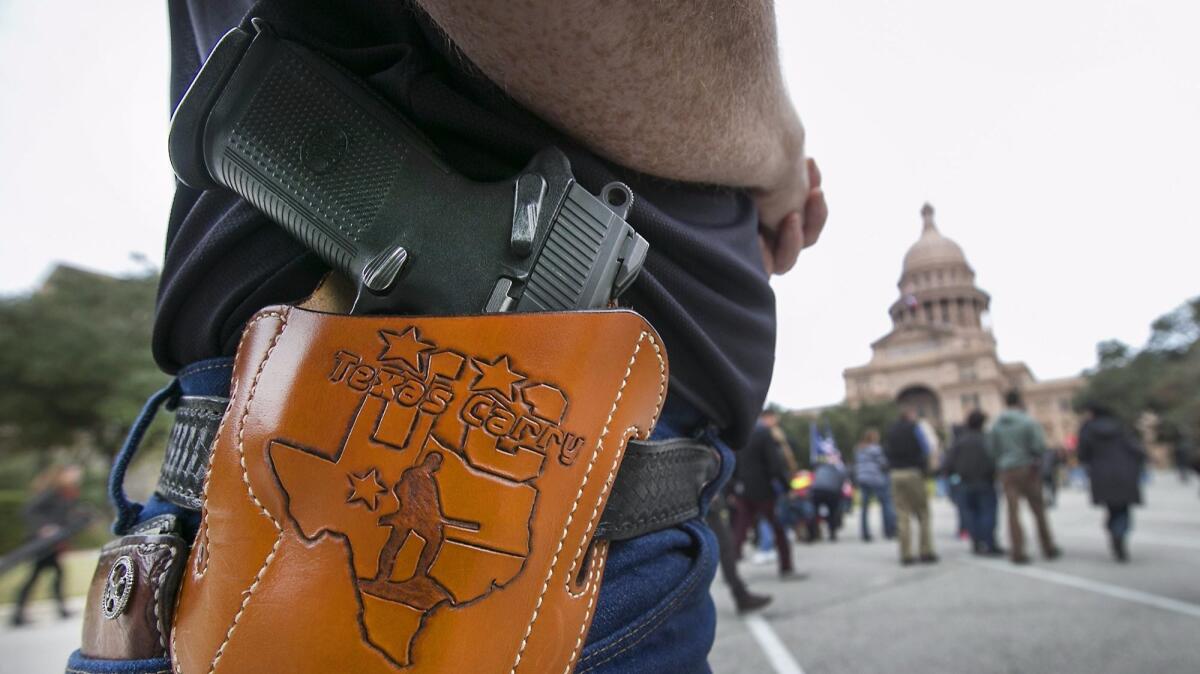Editorial: Protesters need safe spaces to demonstrate, not the right to carry tiki torches and glass bottles

- Share via
Hoping to head off the violence that’s arisen at protests in Charlottesville, Berkeley and other cities, the Los Angeles City Council is drafting a long list of items that would be banned from rallies, demonstrations and public assemblies.
The council’s move, however, has triggered a protest of its own — from some civil liberties groups. They argue that preventing people from taking potential weapons to a protest that they would be legally entitled to bring to other events may be unlawful, because it would strip rights from people engaged in a constitutionally protected activity.
That may be a principled stance in some way, but it’s taken to a ridiculous extreme. Protecting the public from harm and ensuring that citizens have a right to protest peacefully are the top priorities here, not preserving the ability to tote a bat or a stun gun.
City leaders and police need to ensure that people can exercise their rights to speak and demonstrate without getting clubbed or triggering a riot.
The council’s proposed list includes weapons that clearly should be prohibited at protests in the interest of public safety and crowd control, such as guns, knives, swords, razor blades, BB guns and stun guns. It’s simply unrealistic to expect police to be able to prevent or contain violence when protesters come to a demonstration armed to the teeth.
Even if there’s agreement on banning certain items, the harder question is which ones. Council members also want to bar objects that have been used as improvised weapons in protester clashes or that can be dangerous in a crowd, including baseball bats, pepper spray, bear repellent, catapults or projectile launchers, super soakers or water cannons, glass bottles, tiki torches, bricks, rocks, ball bearings and shields made of metal, wood or plastic.
The proposed law would also bar signs and banners unless they were constructed of a soft material, such as cloth, paper, thin plastic or cardboard. The city’s attorneys said the goal is to allow free expression while limiting items that can be — and have been — used as weapons. That is, protesters could carry signs, but not metal ones, for example, or signs attached to sharp wooden spears.
To the civil libertarians, the extended list of banned items is an overreach. “An individual does not have fewer rights when engaged in constitutionally protected activities than when going about their daily business,” Melanie Ochoa, a staff attorney for the American Civil Liberties Union of Southern California told the City News Service. “If a mini baseball bat is dangerous, then it is equally dangerous at a Dodgers game or at a public protest.”
It’s true that the city wants to limit peoples’ rights to carry objects into a demonstration, yet some limits along those lines are essential in order to protect more fundamental freedoms: the 1st Amendment rights to free speech and peaceable assembly.
City leaders and police have an obligation to maintain public safety and to ensure that people can exercise their rights to speak and demonstrate without getting clubbed or triggering a riot. If preserving those 1st Amendment rights means barring glass bottles and baseball bats from rallies, well, so be it.
Admittedly, there’s no clear line between what is a potential weapon and what is not. When is a cardboard sign on a stick simply a sign, and when is it potentially dangerous? Critics also argue the list includes items that can be used for self defense, such as shields and pepper spray, leaving demonstrators little means to protect themselves if they’re attacked. Of course, those objects also can be, and have been, used to injure people during melees.
It’s certainly possible that the list of banned objects may grow even longer as protesters and counterprotesters devise more ways to turn ordinary objects into tools of violence. What’s next? Banning skateboards, soda cans and bicycle locks — all of which have been used as weapons in recent protests?
These are no easy answers because this is ultimately a balancing act that requires limiting some personal freedoms in order to protect more fundamental rights.
Los Angeles, thankfully, hasn’t had to deal with the kinds of violent clashes seen in other cities. But city leaders seem to think it’s inevitable. Perhaps it is. A spate of demonstrations in California and across the nation this year have ended in attacks, injuries, arrests and, in the most horrific case, the death of a peaceful protester in Charlottesville.
In response, some lawmakers and advocates have called on cities and college campuses to deny demonstration permits or cancel provocative speakers who might stir violent clashes between protesters and counterprotesters. That’s the wrong answer. It lets the fear of violence trump essential 1st Amendment rights.
The better answer is for cities to use their police powers to prepare for the risk that protests will go awry, while also enacting sensible rules that lessen the risk of violence.
Follow the Opinion section on Twitter @latimesopinion and Facebook.
More to Read
A cure for the common opinion
Get thought-provoking perspectives with our weekly newsletter.
You may occasionally receive promotional content from the Los Angeles Times.









